Haiti has one of the centuries of fascinating history and Caribbean’s most interesting cultures. The monuments in Haiti are so beautiful and amazing. There is a great deal of cultural and historic sites ready to receive intrepid travellers while its leisure tourism industry is very much in the early stages. With turquoise waves gently lapping at golden shores and spectacular sunsets blanketing the landscape in vivid color, Haiti is a piece of paradise taken straight from the movies. Here’s a list of historical monuments in Haiti:
List of Popular Monuments of Haiti
1.The Citadelle

Citadelle Henri Christophe is another famous name of the Citadelle. It is located at the top of mountain Bonnet a L’Eveque, which is 950 meters high. As far as Milot, Public transportation goes, so it is probably the most comfortable to arrange a guide to reach the fort. The narrow road has a length of 6.3 km leading to the fort and starts at the Sans Souci Palace site. The first four kilometres can be driven in a 4WD vehicle or bus. The many bike taxis in the village are also an option for the braver tourist. It is one of the famous monuments in Haiti. The road ends at a car park which has bathroom facilities and gift shops. At this section, the road narrows but can be navigated by bike taxis, horses or on foot.
Read More: Famous Monuments of Colombia
Address: Milot, Haiti.
2. Labadee

On the North Central Coast of Haiti, Labadee is a fenced, secure resort leased by Royal Caribbean. Haiti shares the island of Hispaniola with the Dominican Republic to its east and it is a Caribbean country. Hispaniola Island is to the East of Cuba and is South of the West Indies (e.g. Turks & Caicos Islands). This popular monument in Haiti is completely tourist-oriented. As stated, the site is fenced off from the surrounding area, and passengers are not allowed to leave the property. The whole area of this place is guarded by a private security force, thus, the area is safe. The food and beverages available to cruise guests are brought from the cruise ships. A controlled group of roughly two hundred (200) Haitian merchants have been given sole rights to establish their businesses and sell their merchandise in the resort.
Address: Labadee, Haiti.
3. Notre Dame Cathedral
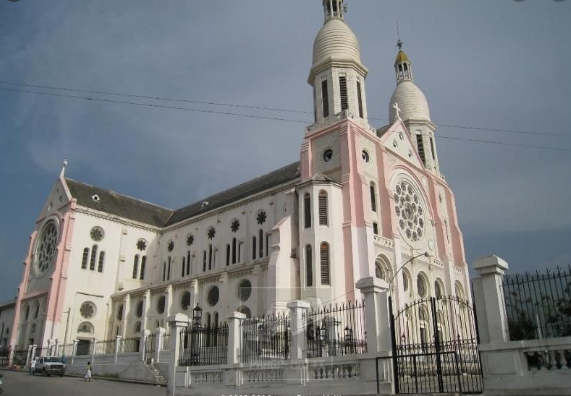
In Cap Hatien, the Notre Dame Cathedral is the main attraction. From the times of French occupation, the architecture is colonial. This religious monument in Haiti is painted white with peach columns and yellow border highlights. The portico over the main double door entrance has a coat of arms on it. On either side of the main entrance side doors, above which are sculptures. There are bell towers on either end of the building which has brown roofs. Below the bell tower area on the left is a clock, and on the right, a cross. At the rear of the church, in a central position, is a large dome which has a cross atop. In the colonial part of Cap Haitien, the cathedral is the central attraction, but if you like old architecture with brightly painted shutters, clean streets and friendly people just sitting about, walk around the area near it.
Read More: Monuments in Mumbai
Address: Centreville, Cap-Haitien Haiti.
4. The Palace of Sans-Souci

By an earthquake in 1842, before it was partially destroyed, the Sans-Souci Palace was home to famous former slave-turned-king Henri Christophe first. The palace evokes a sense of nostalgic beauty with its deep historical roots. This beautiful monument in Haiti is often compared to the majesty of the Palace of Versailles in France. As well as decadent staircases, the Palace features many high-arched windows.
Address: Milot, Nord Department, Haiti
5. Site des Ramiers
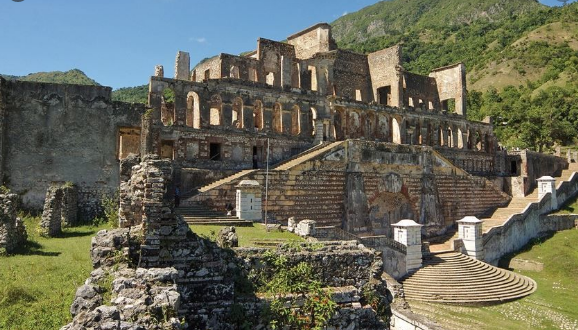
Close to the Citadelle and the Sans-Souci Palace, the buildings at Site des Ramiers are located. Together, the three spots form a designated World Heritage Site, and comprise the largest fortress in the Western Hemisphere. This ancient monument in Haiti is a representation of liberty to the Haitians, as it was one of the first places to be constructed by black slaves who had gained their freedom.
Read More: Buildings in Jaipur
Address: Nord Department, Haiti.
6. Toussaint Louverture Statue
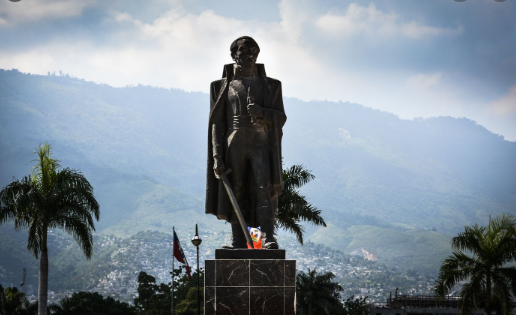
The Toussaint Louverture statue is located at a busy intersection of three streets when entering the central area of Gonaives. The statue stands atop a three tiered base which is placed in the middle of the street. It is one of the best monuments in Haiti. The lower tier is circular, the second is octagonal and the third is in the shape of a cylinder. The top two tiers are tiled. A plaque on the middle tier states, ” Toussaint Louverture, The Precursor of Independence”. The sculpture of Toussaint shows him standing with a sword hanging to his left. He wears a military jacket which covers his shirt with ruffles, which was the style of that era. He also wears a bandana. I had visited a replica of this statue earlier in the day in Ennery. Toussaint was the precursor of independence, as he led the slave rebellion between 1791-1802.
Address: Boulevard Toussaint Louverture, Port-au-Prince, Haiti
7. Place D’armes De La Ville Des Gonaives
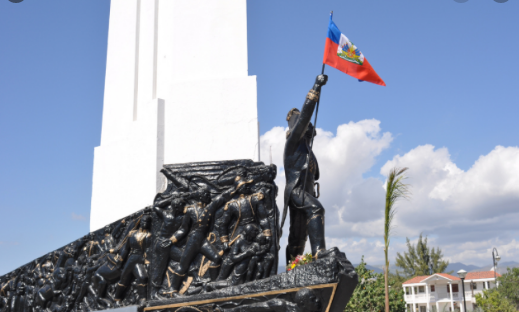
This park is known by locals as independence park. The park has a black metal fence surrounding it, and the entrance is on Rue Vernet. The main colours of this beautiful monument in Haiti are tangerine and green. The main attraction of the park is in the western section. It is a tall white obelisk which has a sculpture of Jean-Jacques Dessalines at the base and reliefs on either side. Dessalines stands with a Hatian flag in his right hand. To his right and left are reliefs of his soldiers and other local fighters. Horses, women and children are also included which makes the monument representative of all Hatians who resisted and fought for freedom. People also called this monument as the “monument of the natives”.
Read More: Monuments of Chile
Address: Rue Vernet, Les Gonaïves, Haiti.
8. Place Bouteille
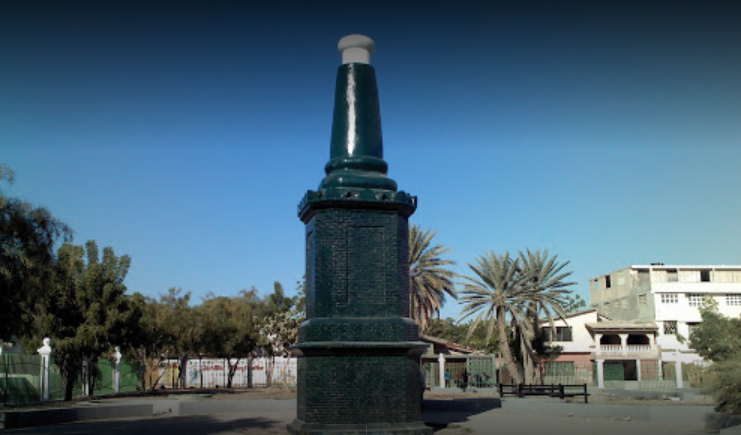
Bottle Park is located in the center of town, between Rue Louverture and Route Nationale no. 1. The centerpiece of the park is a sculpture of a green bottle. This old monument in Haiti is built of brick and has a white top which represents a bottle cork. All paths in the park lead to the bottle. There are a few benches and covered areas where one can sit and relax. The park was in need of repair and garbage-strewn. This was disappointing because it is the historic site where the Haitian declaration of independence was written on 31 December 1803.
Louis Boisrond-Tonnerre who penned the document is said to have been found in his house, drunk with a bottle in hand, on the night before independence from France was declared. The bottle marks are the location of the house of Louis. Louis lived between 1776-1806 and is best known as the secretary of Jean-Jacques Dessalines.
Address: Gonaives, Haiti
9. Petite Place De L’eglise
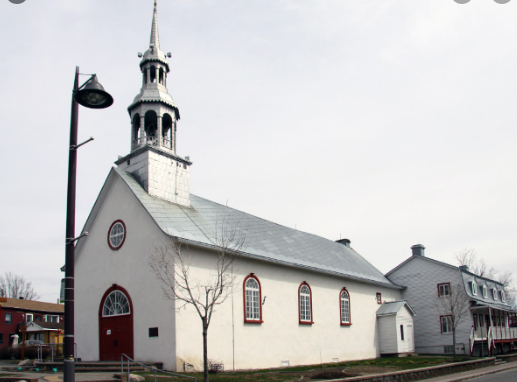
The Small Church Square is located opposite the St. Pierre catholic church. It is a park where one can relax and enjoy the surroundings. The centerpiece of the square is a sculpture of the Nègre Marron (Black Maroon). This important monument in Haiti is a replica of the famous sculpture in Port au Prince, which was done by Albert Mangonès. This sculpture is known worldwide and represents the freedom of slaves. The sculpture is also known as “the unknown slave”. The slave is shown on bended knee with an abeng (conch shell) held in his left hand and pressed to his lips. In his right hand, he holds a machete. On the left leg of the maroon is a broken shackle which represents his fight for freedom. The abeng was used as a means of communication during the slave rebellion.
Read More: Monuments in Madrid
Address: Petite Place de l’Eglise, Limbé, Haiti.
10. Jose Marti Square
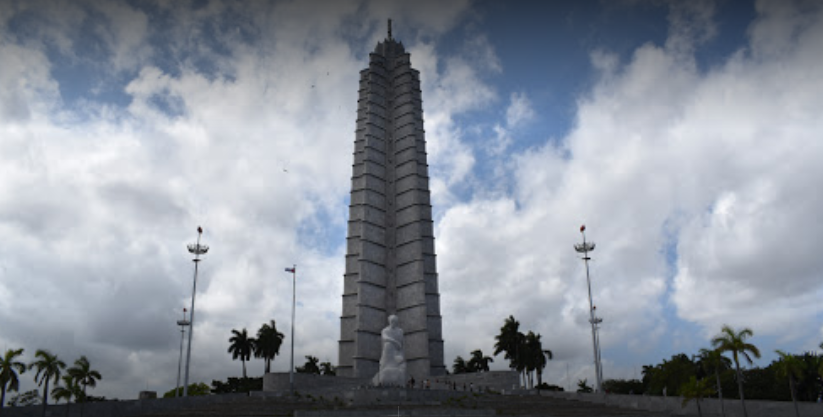
At the southern end of Rue 17A, the Jose Marti monument is located in the square named in his honour. This area is near to the intersection with Rue A. In the eastern section of the park, it is a narrow park with a few trees and the bust of Jose Marti. The park is not in the best condition as the fountain was not working and the bust was chipped and in need of painting. It is the most popular monument in Haiti. On a plaque near to the park entrance, the visits of Marti to Haiti between 1892-1895 are mentioned. In particular, it references his time in Cap Hatien, and meetings with Anténor Firmin. The plaque also mentions the poetic verses written by Marti, which were included in the famous “Guantanamera” song and the date which he left Cap Hatien for Cuba, 7 April 1895.
Address: Cap-Haitien, Haiti.
So far we have discussed the best monuments in Haiti, which contains the proper information regarding all the most visited monuments in Haiti. I hope you might have loved reading this article and if you love to know more about Haiti then kindly head to our other articles as well which will help you to get knowledge about.
The post Most Visited Monuments in Haiti l Famous Monuments in Haiti appeared first on World Tour & Travel Guide, Get Travel Tips, Information, Discover Travel Destination | Adequate Travel.